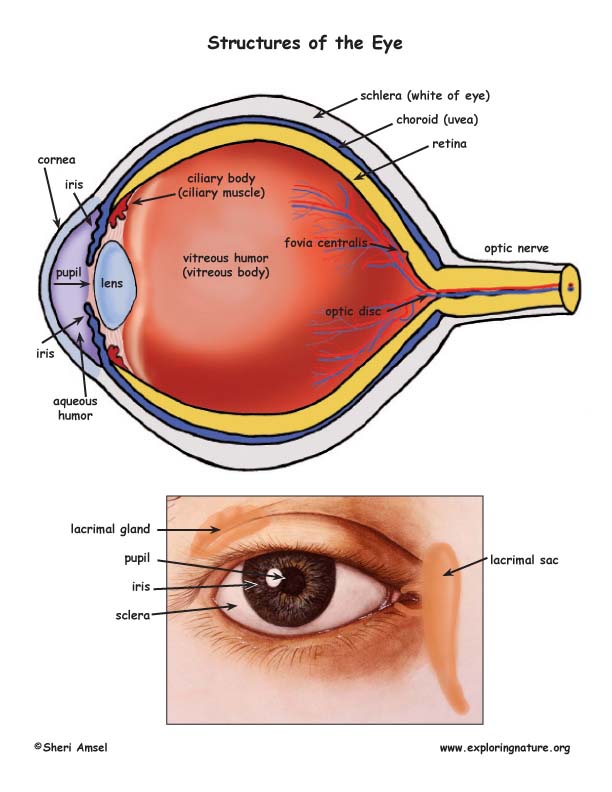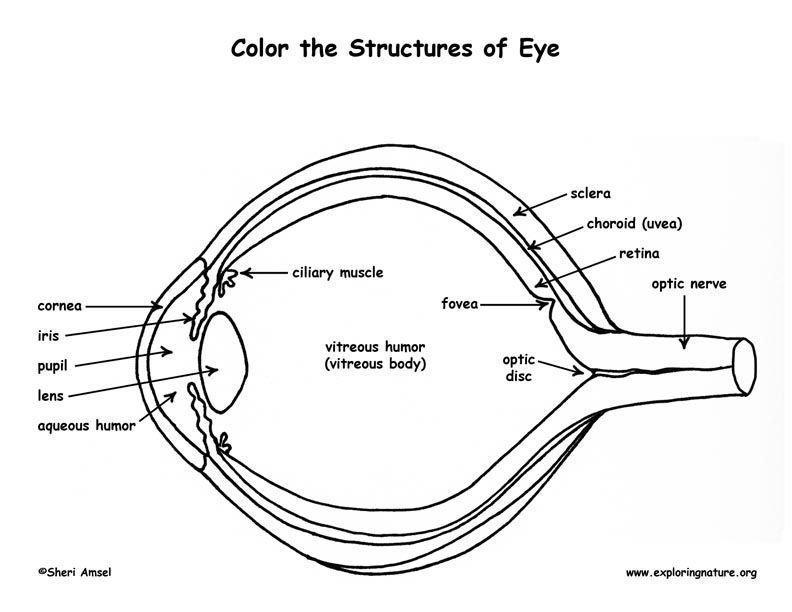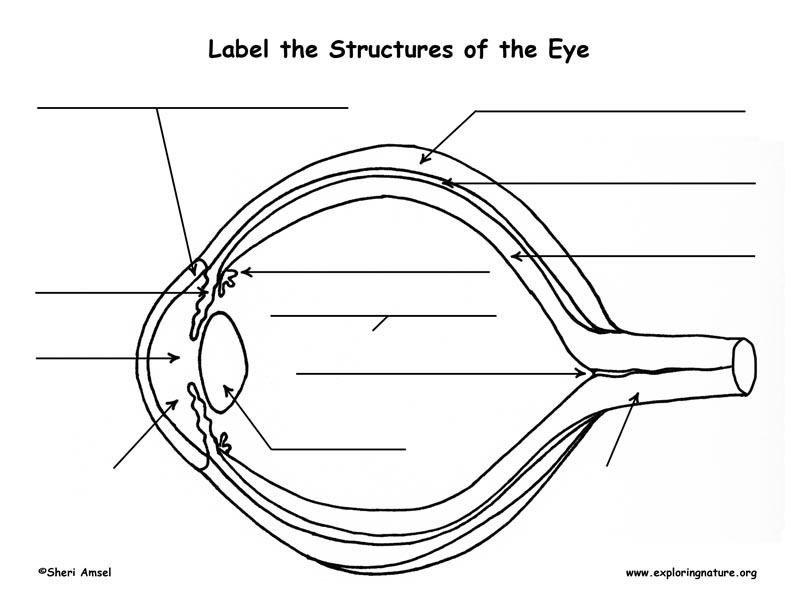

Eye Facts
The eye is a sensory organ – 70% of all sense receptors are in the eye. There are over a million nerve fibers bringing vision signals to the brain. The adult eyeball is a sphere about one inch wide. Only a small part of it (16%) is visible. The rest is protected inside the skull and padded with fat.
Many organs help with sight. Eyebrows shade the eyes from sunlight and protect the eyes from dripping sweat. Eyelashes protect the eyes by blinking with lightning speed when something touches them. Eyelids protect the eyes and regular blinking keeps them from getting dried out. Every time you blink, a tiny gland above your eye (lacrimal gland) sends some fluid across the eye to keep it moist. The fluid in the eyes drains out through the lacrimal sac between them and down into the nose. This is why you get the sniffles when you cry or when your eyes tear from cold wind. Eye muscles move the eyes around in their socket allowing a range of vision without moving the head.
The eyeball itself is hollow, filled with fluid that helps keep its shape. It has 3 layers - the sclera, choroid and retina.
• The outer layer – the sclera is the white of your eye. In the very center it becomes clear. This part is called the cornea.
• The middle layer – the choroid or uvea is what you see in the eye as iris. The opening in the center of the iris is the pupil. The pupil allows light to get into the eye. The iris, made up of tiny muscle fibers, can open the pupil larger in darkness (dilate) or close it smaller in bright light (contract).
• The inner layer of the eye is the retina. The retina has millions of nerve endings, called, “photoreceptors” that receive what we see and send it on to the “optic disc,” which sends the message onto the brain through the optic nerve. The optic disc has no photoreceptors of its own, so is the “blind spot” of the eye. At the center of the field of vision, there is a small depression in the retina called the fovea centralis where there is the highest concentration of photoreceptors. This area of the retina has the most acute vision.
Photoreceptors come in 2 forms. Rods see in dim light and out of the corners of your eyes (peripheral vision). They let you see things in black and white. Cones see in bright sunlight, color, and sharp images. There are 250 million photoreceptors (rods and cones) in the retinas of your eyes.
The Passage of Light
When light enters the eye, it passes through the cornea, pupil and lens (which can change shape to focus on things near or far) and through the vitreous fluid in the eye. Then it enters the retina. The rods and cones will then send what they see – the visual stimulus – onto the brain via the optic nerve, so that you can understand and interpret what you are seeing. The vision center of the brain is in the occipital area of the brain in back of the head. This may explain why a blow to the back of the head causes one to see flashing lights (or seeing “stars”).
Eye Problems
Color blindness is when you are missing the cones for either red or green and see them as the same color. Many color-blind people don’t even know they are color blind until they are tested. It is much more common in boys than in girls.
Eyes can be damaged by too much sunlight. This is why it is recommended that you never look directly into the sun and if you are going to be in the sun for a long time, you should wear good sunglasses. Sunglasses should be UV protective sunglasses so they are filtering out the most harmful rays. The UV stands for ultraviolet light.
Scientists have discovered that people blink less if they are concentrating on an action computer game. Blinking keeps your eyeballs moist, so many hours of not blinking enough can dry them out. Besides for making your eyes red, this can lead to eye strain and headaches. Take a break, rest your eyes and remember to blink.
______________________________________________________________________________________
Assessment:
Structures of the Eye with Vocabulary Provided - Labeling
Vision and the Structures of the Eye - Multiple Choice
Draw the Anatomy of the Eye.
______________________________________________________________________________________
LS1.D Information Processing
K-2 Animals sense and communicate information and respond to inputs with behaviors that help them grow and survive.
3-5 Different sense receptors are specialized for particular kinds of information; Animals use their perceptions and memories to guide their actions.
6-8 Each sense receptor responds to different inputs, transmitting them as signals that travel along nerve cells to the brain; The signals are then processed in the brain, resulting in immediate behavior or memories.
When you research information you must cite the reference. Citing for websites is different from citing from books, magazines and periodicals. The style of citing shown here is from the MLA Style Citations (Modern Language Association).
When citing a WEBSITE the general format is as follows.
Author Last Name, First Name(s). "Title: Subtitle of Part of Web Page, if appropriate." Title: Subtitle: Section of Page if appropriate. Sponsoring/Publishing Agency, If Given. Additional significant descriptive information. Date of Electronic Publication or other Date, such as Last Updated. Day Month Year of access < URL >.
Amsel, Sheri. "Vision and the Structure of the Eye" Exploring Nature Educational Resource ©2005-2024. December 13, 2024
< http://www.exploringnature.org/db/view/Vision-and-the-Structure-of-the-Eye >



